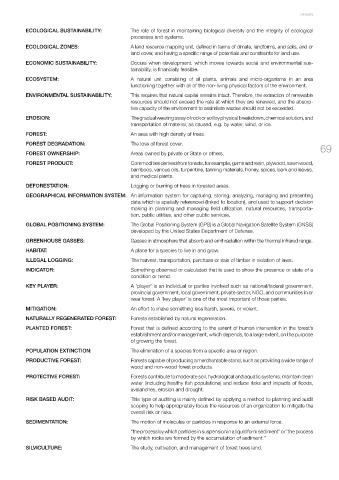Page 69 - 4. Pre-Course Reading-Training on Forestry Audit 2019
P. 69
Glossary
ECOLOGICAL SUSTAINABILITY: The role of forest in maintaining biological diversity and the integrity of ecological
processes and systems.
ECOLOGICAL ZONES: A land resource mapping unit, defined in terms of clmate, landforms, and soils, and or
land cover, and having a specific range of potentials and constraints for land use.
ECONOMIC SUSTAINABILITY: Occurs when development, which moves towards social and environmental sus-
tainability, is financially feasible.
ECOSYSTEM: A natural unit consisting of all plants, animals and micro-organisms in an area
functioning together with all of the non-living physical factors of the environment.
ENVIRONMENTAL SUSTAINABILITY: This requires that natural capital remains intact. Therefore, the extraction of renewable
resources should not exceed the rate at which they are renewed, and the absorp-
tive capacity of the environment to assimilate wastes should not be exceeded.
EROSION: The gradual wearing away of rock or soil by physical breakdown, chemical solution, and
transportation of material, as caused, e.g. by water, wind, or ice.
FOREST: An area with high density of trees.
FOREST DEGRADATION: The loss of forest cover. 69
FOREST OWNERSHIP: Areas owned by private or State or others.
FOREST PRODUCT: Commodities derived from forests, for example, gums and resin, plywood, sawn wood,
bamboos, various oils, turpentine, tanning materials, honey, spices, bark and leaves,
and medical plants.
DEFORESTATION: Logging or burning of trees in forested areas.
GEOGRAPHICAL INFORMATION SYSTEM: An information system for capturing, storing, analyzing, managing and presenting
data which is spatially referenced (linked to location), and used to support decision
making in planning and managing field utilization, natural resources, transporta-
tion, public utilities, and other public services.
GLOBAL POSITIONING SYSTEM: The Global Positioning System (GPS) is a Global Navigation Satellite System (GNSS)
developed by the United States Department of Defense.
GREENHOUSE GASSES: Gasses in atmosphere that absorb and emit radiation within the thermal infrared range.
HABITAT: A place for a species to live in and grow.
ILLEGAL LOGGING: The harvest, transportation, purchase or sale of timber in violation of laws.
INDICATOR: Something observed or calculated that is used to show the presence or state of a
condition or trend.
KEY PLAYER: A ‘player’ is an individual or parties involved such as national/federal government,
provincial government, local government, private sector, NGO, and communities in or
near forest. A ‘key player’ is one of the most important of those parties.
MITIGATION: An effort to make something less harsh, severe, or violent.
NATURALLY REGENERATED FOREST: Forests established by natural regeneration.
PLANTED FOREST: Forest that is defined according to the extent of human intervention in the forest’s
establishment and/or management, which depends, to a large extent, on the purpose
of growing the forest.
POPULATION EXTINCTION: The elimination of a species from a specific area or region.
PRODUCTIVE FOREST: Forests capable of producing a merchantable stand, such as providing a wide range of
wood and non-wood forest products.
PROTECTIVE FOREST: Forests contribute to moderate soil, hydrological and aquatic systems, maintain clean
water (including healthy fish populations) and reduce risks and impacts of floods,
avalanches, erosion and drought.
RISK BASED AUDIT: This type of auditing is mainly defined by applying a method to planning and audit
scoping to help appropriately focus the resources of an organization to mitigate the
overall risk or risks.
SEDIMENTATION: The motion of molecules or particles in response to an external force.
“the process by which particles in suspension in a liquid form sediment” or “the process
by which rocks are formed by the accumulation of sediment.”
SILVICULTURE: The study, cultivation, and management of forest trees land.

